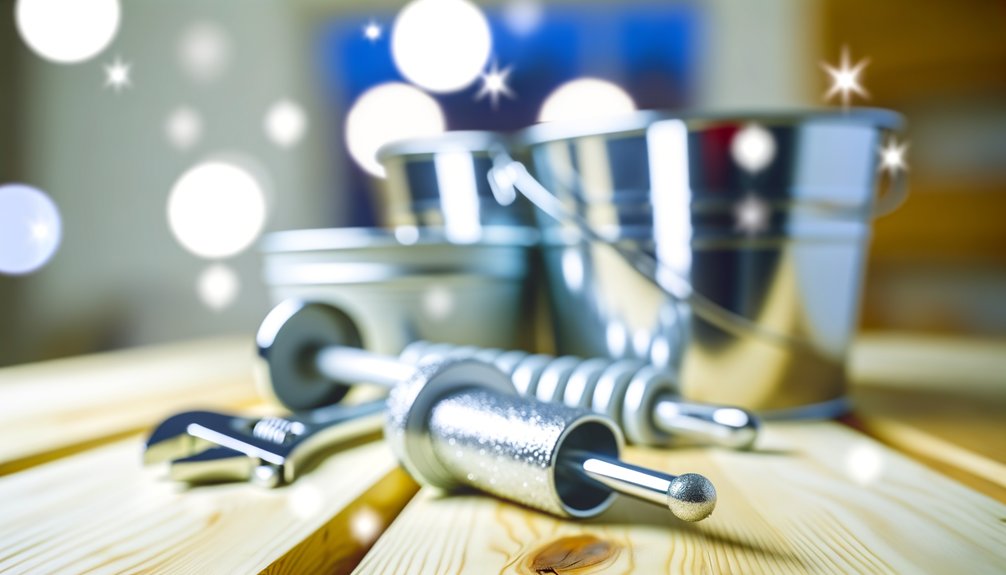DIY tools for unclogging pipes quickly include plungers, baking soda and vinegar, and wire hangers. Plungers create suction to dislodge minor clogs in sinks, tubs, and toilets. The baking soda and vinegar combination generates fizzing bubbles that break down buildup. A wire hanger can be shaped into a hook to retrieve debris from drains. Each method is effective for different types of blockages. For a thorough understanding of these tools and their usage, further insights await.
Plunger: The Classic Tool for Quick Clogs

Although many homeowners may overlook its simplicity, the plunger remains a fundamental tool for addressing minor clogs in various plumbing fixtures. This device operates by creating suction, which effectively dislodges blockages in sinks, tubs, and toilets. For peak performance, it is recommended that homeowners utilize a sink or tub-specific plunger, characterized by a smaller size and shallow suction cup designed to create a better seal over the drain. Ensuring the plunger is clean prior to use enhances suction, thereby improving efficiency. This classic tool is particularly adept at managing light clogs caused by hair and soap accumulation, making it a cost-effective initial choice before considering more advanced techniques. However, frequent plunging may indicate more severe blockages, suggesting the need for specialized tools or professional intervention if the initial method proves ineffective. The plunger remains an essential ally in the quest for quick resolution of plumbing issues.
Baking Soda and Vinegar: A Natural Solution
For homeowners seeking an alternative to mechanical tools like plungers, baking soda and vinegar offer a natural solution for unclogging pipes. This cost-effective method utilizes common pantry ingredients, making it accessible for DIY enthusiasts. By combining ½ cup of baking soda with ½ cup of vinegar, a chemical reaction occurs, producing fizzing bubbles that help dislodge and break down buildup in drains. This bubbling action is particularly effective against hair, soap scum, and other debris that commonly cause clogged drains. After allowing the mixture to sit for at least one hour, it is essential to flush the drain with boiling water to clear away any remaining residue. Regular use of this home remedy not only unclogs existing drains but also serves as a preventative measure, maintaining clear plumbing and reducing the likelihood of future clogs.
Wire Hanger: The DIY Drain Hook

Crafting a DIY drain hook from a wire hanger provides an effective solution for tackling stubborn clogs. This DIY method involves deconstructing a wire hanger to form a small hook at the end, allowing for precise maneuvering within drainage systems. To utilize this tool, the user should first remove the drain cover, then insert the hook and wiggle and rotate the wire to dislodge clogs. The wire hanger excels at addressing shallow clogs, making it a practical choice among common household items. After retrieving debris, flushing the drain with hot water can help remove any remaining buildup and improve drainage. For enhanced results, this technique can be combined with other methods, such as baking soda and vinegar. Overall, the wire hanger serves as a cost-effective alternative to expensive plumbing services, empowering individuals to manage their plumbing issues with ease.
Frequently Asked Questions
How Do You Unclog a Pipe Fast?
To unclog a pipe quickly, one can utilize various plumbing tips and emergency solutions. Effective household hacks include using a plunger for immediate blockage dislodgement and employing a manual drain snake for deeper clogs. Boiling water can dissolve grease, while baking soda and vinegar create a fizzing reaction for mild clogs. Additionally, crafting a wire hanger can assist with surface debris removal. Regular pipe maintenance and drain cleaning enhance water flow and aid in clog prevention.
How Do You Unclog a Drain ASAP?
In an emergency repair scenario, a homeowner faced a stubborn kitchen drain blockage. To unclog the drain swiftly, they employed effective drain cleaning techniques. Utilizing boiling water, they initiated the process, followed by a baking soda and vinegar combination. They then relied on a plunger to enhance water flow, ensuring ideal drain health. Finally, a drain snake tackled the remaining debris, showcasing essential plumbing tools and DIY solutions for efficient pipe maintenance and unclogging techniques.
How Do You Make Homemade Drain Unblocker?
To create a homemade drain unblocker, one can utilize various recipes. A common method involves a salt mixture with baking soda and vinegar, which triggers chemical reactions that break down clogs. For enhanced effectiveness, adding enzyme cleaners or liquid soap can aid in dissolving grease. Following treatment, flushing with boiling water guarantees debris removal. Additionally, citrus peels or coffee grounds can serve as eco-friendly solutions, providing natural scents while combating blockages.
How to Make a DIY Drain Snake?
In the battle against stubborn clogs, the DIY drain snake emerges as a hero crafted from household items. To create this effective tool, unwind a wire hanger, leaving a small hook for snagging debris. Following DIY plumbing tips, remove the drain cover, insert the snake, and wiggle to dislodge blockages. This cost-effective method serves as an emergency fix for pipe maintenance, offering clogged drain solutions and preventative measures for future issues.



